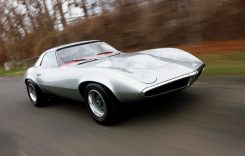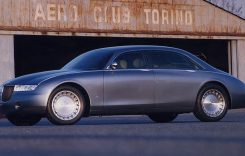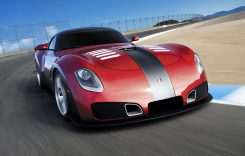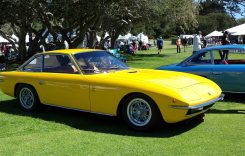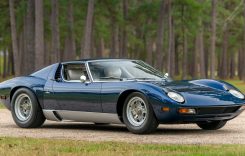
Suzuki’s iconic GSX-R750 ($12,299 base, $13,148.95 as tested) is a proven workhorse. It’s a carefully crafted package that has been fine-tuned over three decades offering the ultimate in versatility and accessible performance. Powered by an ultra-smooth, yet muscular 749cc Inline Four engine within a lightweight and easy to manage chassis the GSX-R should be a shoe in for street supremacy.
In contrast to the elegant and carefully sculpted lines of the Italians, the Suzuki offers more cartoonish proportions. Still, some might be attracted to its appearance but it certainly won’t get you noticed like you would at the controls of the Ducati or MV.
“You get off exclusive, exotic bikes like the Ducati and then you get it on the GSX-R, which, when you look at it, ‘it’s just another Japanese superbike’,” explains Northover. “But it’s great to ride. It’s fast, it’s smooth, it’s predicable, it’s comfortable.”
Seated at the controls the GSX-R offers a well-padded and rider-friendly seat that’s a smidge lower than the MV and over a 0.5 inch less than the Ducati. Due to the configuration of the engine, it is a little wider through the mid-section, but not by much.
Grab a hold of the clip-ons and you’ll notice their narrower bend in contrast to the wider set-ups on the Ducati and MV, yet it proved to be the most accommodating. Another clever touch is the ability to alter the position of the rider’s footpegs, based on preference. We prefer the lower/rearward setting as it opens up the cockpit and makes the GSX-R surprisingly comfortable for all-day rides.
(Top) The GSX-R750’s Inline Four was the least powerful in terms of peak power. However, it had the broadest powerband which made it easy to ride on the road. (Center) The cockpit of the GSX-R750 is functional and without thrills. It also employs a BPF-enabled Showa front suspension with independent compression and rebound circuits located atop the fork legs. (Bottom) The Suzuki’s cockpit is the most comfortable and the most adept at all-day rides.
“Man, that bike’s everyone’s old friend,” describes the Brit. “It’s like an old coat you’ve worn for years. You chuck it on and go out into the rain.“
The Gixxer delivers a supple yet well-dampened and highly balanced ride. Its chassis is also the most stable but it isn’t quite as agile as the competition. And despite its best-in-class curb weight of 427 pounds, it didn’t feel the lightest in motion. Nevertheless, it didn’t hold us back from having a good time.
“Maybe it is a bit more cumbersome than the MV or Ducati, but it never bothered me on the street,” Chris reveals.
We were generally pleased with the function of the Suzuki’s brakes. Sure, they’re not quite as sharp initially as the other set-ups, they are easy to get a feel and plenty powerful when you get into the lever. Proven by the 10-foot shorter stopping distance compared to the F3. However it was 6.7 feet behind the class-leading Ducati (w/ ABS off).
Instrumentation is basic but functional and it’s easy to read the GSX-R’s vitals at a glance. The electronics are simpler, too, with it only offering two selectable engine maps. However the only time you might engage the slow ‘B’ map is for riding on slippery surfaces, or perhaps if you’re a less-experienced rider seeking a more forgiving experience.
Dyno testing reveals the GSX-R’s engine is the least powerful, cranking out the lowest peak torque figure of 55.26 lb-ft at 11,000 rpm. That’s 3.69 less than the F3 and nearly 10 lb-ft down on the class-leading Panigale. It was a similar story in the horsepower war with it pumping out 7.16 ponies less than the MV and almost five fewer than the 899.
Still, the Suzuki’s engine offers the widest spread of juice. It’s smooth power, too, allowing the rider to flog the machine harder than they might be comfortable with on the erratic MV or hard-hitting Ducati.
“Every time you ride it you are reminded of how good of a bike it is,” Chris tells. “I never got bothered by the lack of traction control. I never worried about the lack of ABS. I just got on it hit the corners hard and it just put a big smile on my face every time I got near it… oh yeah, and it does the best wheelies, too.”
GSX-R750 Settings
Suspension
Fork
Preload: 4 (Turns in)
Compression: 5 (Turns out)
Rebound: 4
Shock
Preload: +2 turns from stock
Low-Speed Compression: 2.25
High-Speed Compression: 3
Rebound: 2
Z-FI TC: 0 (baseline)
Although the Suzuki lacks traction control from the factory, as Chris points out, the synergy between the engine and chassis mitigate the need for it to a certain degree.
Systems are available through the aftermarket, like the $849.95 Bazzaz Z-FI TC unit that was easily retrofitted to our test bike. Due to limited riding time we didn’t get to play with its settings, opting to leave in the baseline ‘pro’ map but it was nice to know that help was there if we hit gravel or any other type of hazard on the road.
At the drag strip, the Suzuki was an easy bike to launch. It has the finest clutch (with true slipper functionality) and the transmission is the most precise between gears. The addition of the Bazzaz quickshifter made a significant improvement when running through the gearbox and despite being the slowest to 60 mph (the Suzuki has the tallest first gear) it outgunned the stronger MV through the quarter-mile (10.88 seconds) while recording the highest trap speed (135.8 mph).
(Top) The GSX-R750 doesn’t come fitted from the factory with a quickshifter but the folks from SoCal’s Bazzaz Performance fitted the set-up as part of its Z-FI TC black box that uses the Suzuki’s OE sensors to enable a rate-of-change based traction control system. (Center) The Suzuki offers the most stable and predictable handling. Though we wish it was a hair more responsive during turn-in. (Below) Although Suzuki was the first Japanese brand to adopt monobloc braking hardware from Brembo the set-up wasn’t our favorite on the street.
While lacking the raw and exhilarating character of the Italians, the Suzuki still has some flavor, delivering a pleasing mechanical chorus when the throttle is pinned. Yet, it remains neighborhood-friendly emitting the least amount of noise both at idle, and at speed.
“It makes a great noise,” tells Chris. “The airbox howl is a thing Suzuki is famous for and makes the hairs on your neck stand up when you hit the throttle. It’s just such a really nice bike to ride.”
The engine proved to be the most economical too, recording a 32.9-mpg average. That netted a best-in-class range of 147 miles between fill-ups based on the 4.5-gallon capacity of its fuel tank (same as the Ducati and over a quart larger than the MV).
As usual the GSX-R continues to astound us with its elegance. From braking, to acceleration, and handling, through any type of corner, it would be hard to find a more comfortable and easy to ride sportbike than the Suzuki. But while rich in character for a Japanese bike, it still comes up short against the mechanical beauty of the euros. It also lacks factory-installed electronics including ABS and traction control—key features for less-experienced riders. So despite its polish, the GSX-R finishes second, a mere three points behind first place.
Suzuki GSX-R750 Highs & Lows
Highs
- Highly refined riding dynamic
- Very comfortable to rack up miles on
- Flexible and easy to use engine
Lows
- Lacks factory-installed electronics like traction control and ABS
- Engine has the lowest peak power numbers
- Lacks the styling panache of the Italian machinery
2014 Suzuki GSX-R750 Specs

Engine: Liquid-cooled 750cc Inline-Four, 16-valves
Bore and Stroke: 70.0 x 48.7mm
Compression Ratio: 12.5:1
Fuel Delivery: Fuel-injection
Clutch: Wet multi-plate slipper clutch; Cable actuation
Transmission: Six-speed
Final Drive: Chain 16F/43R
Frame: Twin-spar aluminum
Front Suspension: 43mm inverted Showa BPF; 3-way adjustable for spring preload, compression and rebound damping; 4.7 in. travel
Rear Suspension: Showa gas-charged shock; 4-way adjustable for spring preload, high/low-speed compression and rebound damping; 4.9 in. travel
Front Brakes: 300mm discs with radial-mount Brembo monobloc four-piston calipers
Rear Brake: 220mm disc with single-piston caliper
Tires: Bridgestone BT-016; 120/70R17, 180/55R17
Curb Weight: 425 lbs
Wheelbase: 54.7 in.
Seat Height: 31.9 in.
Fuel Capacity: 4.5 gallon
MSRP: $12,299
Colors: Black/Silver; Blue/White
Warranty: 12-month, unlimted mileage 12-month, unlimted mileage

